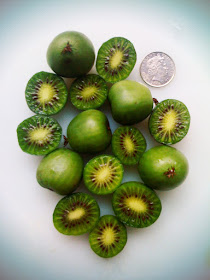I really love foraging and I miss all the berries that I used to pick in Italy. I learned from a Maori forest ranger that you can eat the berries of the
kahikatea tree (the red aril, not the blue seed) and I have a large tree in front of my house that is fruiting right now. The only problem is that the tree is so tall that I cannot reach the berries (the native birds are probably happy for it), so I have to content myself with picking just a few from the ground. It is hard work, I'll never be able to make jam with the quantities I am getting, but I did make a flan with kawakawa creme and kahikatea berries before (for the recipe, and a photo of the berries click
here), and this time I made cupcakes.
I asked my little boy to pick a few berries and then I rinsed them. I added a few drops of lemon juice and 1 tsp of sugar, and let the berries marinate overnight. The day after I made my usual vanilla cupcakes and added a few of the berries, strained.
I used the pink juice to make a little icing by adding a couple of tsp of icing sugar. And then I decorated the cupcakes with a fresh kahikatea berry. They were a hit with my guests who, although being real Kiwis, have never eaten the berries before, or anything made with them.
Since kahikatea berries can only be found in New Zealand, I am re-using this recipe for
Sweet New Zealand, hosted by
Sue
And now to writing a cookbook: yes it has been a long time since the last post on this subject, and the reason that I am picking it up now is that... I cannot give you a recipe for these cupcakes! They are my basic vanilla cupcakes, and one of my trusted (and most cherished) recipes, but since it belongs to my new book (due to be published in September) I have to keep it... secret! So, for now just use your own favourite cupcake recipe, and just add the berries to it!
These months have been dedicated to editorial, design and proofreading, a long process really, but really vital. At this stage you, the author, are working with other people, generally by email or phone, or on paper. The manuscript, and then the first proofs, keep going back and forward between all involved to set the pages, add the photos, correct the mistakes, rewrite the recipes that don't fit the page, check the page numbers, and makes all the changes and additions that are necessary.
You have to be patient, open minded, ready to compromise, and ready to make your point when you feel strongly about something. Don't loose your cool, or your manners: often it is not a questions of who is right of wrong, but what works best for the book itself. If your brilliant childhood reminiscence doesn't fit the page, so be it! Let it go! (Unless it is vital to the recipe, of course!). But if one of the step by step photos is missing, and you really think that you cannot do without that one, or if the editor has suggested a change that is not necessary, or improving the book, stand up for it.
For this process it is useful if you know how to correct proofs and make changes by using
proofreader marks. If you are not in the publishing business you can find some good books as reference. Remember that your editors, designer and proofreaders will all be using these 'symbols', so it really helps to understand them.
So, in the last few months I have been working on this, plus writing a glossary, an index and a conversion table. Not creative as writing recipes perhaps, but still an important part of the process.
Sometimes the index is written by a third person; if you are not confident with writing your own index speak to the publisher: a good index is very important in a cookbook.
As a last word of advice: always use a courier to deliver the proofs (or deliver them yourself): they are too important to get lost in the mail!
Next time I will talk about the book cover, till then... keep on planning that cookbook of yours!
Photos and Recipes by Alessandra Zecchini ©






















































